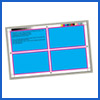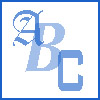Digital Training Center |
|||||||||||||
Help with... |
|||||||||||||
 |
|||||||||||||
| Creating an Adobe ® PDF | |||||||||||||
 |
PDF's are the fastest, most economical way to submit your files. Most Adobe® programs support easy export of PDF files. It is important to use the preset [Press Quality] when exporting for print use. This will allow for accurate color interpretation and separation. It will also insure that the document is of the necessary resolution. If your program does not support PDF export. You can use www.adobe.com to create a PDF out of most popular file types.
|
||||||||||||
 |
Collecting your Fonts and Images | ||||||||||||
When you upload your files to us, always check that in addition to the document file and image files, you include font files for all the fonts used in your document. In later versions of programs like QuarkXpress and InDesign there is a “collect for output” feature that will gather all fonts for you. FONT FILES: Find out all the fonts you are using in the document. Locate where the fonts are stored on your computer. On the Macintosh the fonts folder is on your primary hard drive by default. On the PC you can find your fonts in the Control Panels Menu under Fonts. You can also use font manager software to collect the fonts you need. IMAGE FILES: There are several programs that require you to keep a copy of the images with the document. Place the images you use in your document in a folder named, images, graphics, or links. This will insure that the pictures and logos in your document are output at the highest possible resolution. PDF FILES: PDF files allow you to include all of the fonts and images you need it one high quality file. See Creating a PDF. |
|||||||||||||
| File Submission Guidelines | |||||||||||||
 |
If you are unable to create a PDF, please use the following guidelines below to prepare your file for output. DOCUMENT SIZE: Create your document to the exact final size you want printed. If you are supplying a PDF, please use crop marks and allow for bleeds. BLEED AREAS: All bleeds should be set up to a MINIMUM OF 1/8" beyond trim. PHOTOSHOP FILES: All imported Photoshop® files should be saved as CMYK, Grayscale, Monotone or Duotone, for images and Bitmap for lineart. Do not use RGB, LAB, or Index Color. • Save files as EPS, or TIFF files at 300 DPI. Do not use LZW compression. • Rotate, scale, etc. all picture files within the program before importing in your document layout. FONTS: Do not use the type style menu, or control bar to stylize your type. Select the actual stylized font from the font menu. For example, use Arial Bold instead of applying a "bold" style to the Arial font. Please see the Collecting your fonts and images section. COLORS: Delete all the unused colors from all the elements of your document in the native program that you used to create them. ILLUSTRATOR®/FREEHAND®/COREL®: Convert fonts to outlines and save as EPS — no embedded fonts. Include the original files for all placed images. PREPARATION OF DISK FOR OUTPUT: Please put all placed or imported elements of your final document into one folder. Delete all other files from disk that are not used for your final document. |
||||||||||||
| Preparing your Images for Press | |||||||||||||
 |
All imported Photoshop® files should be saved as CMYK, Grayscale, Monotone or Duotone for images and Bitmap for lineart. Do not use RGB, LAB, or Index Color. DPI: The optimum resolution for scanned images is 300 dots per inch (DPI) at actual size. Any more than this, and it will increase the file size with no benefit and any less will start to affect the quality of the image. Megapixels: Digital cameras above 3 megapixels should yield good quality images for use in most projects. However, digital images are usually captured at a 72 DPI resolution. These can be converted to 300 DPI in most popular photo editing software. • Save files as EPS, or TIFF files. Do not use LZW compression. • Rotate, scale, etc. all picture files within the program before importing in your document layout. |
||||||||||||
| HOME • SERVICES • PRODUCTS • SUPPORT • TOOLS • ABOUT • LOCATIONS • CONTACT
US • TERMS OF USE • SITE MAP |
|||||||||||||
©
Creative Color Graphics, Inc. |
|||||||||||||